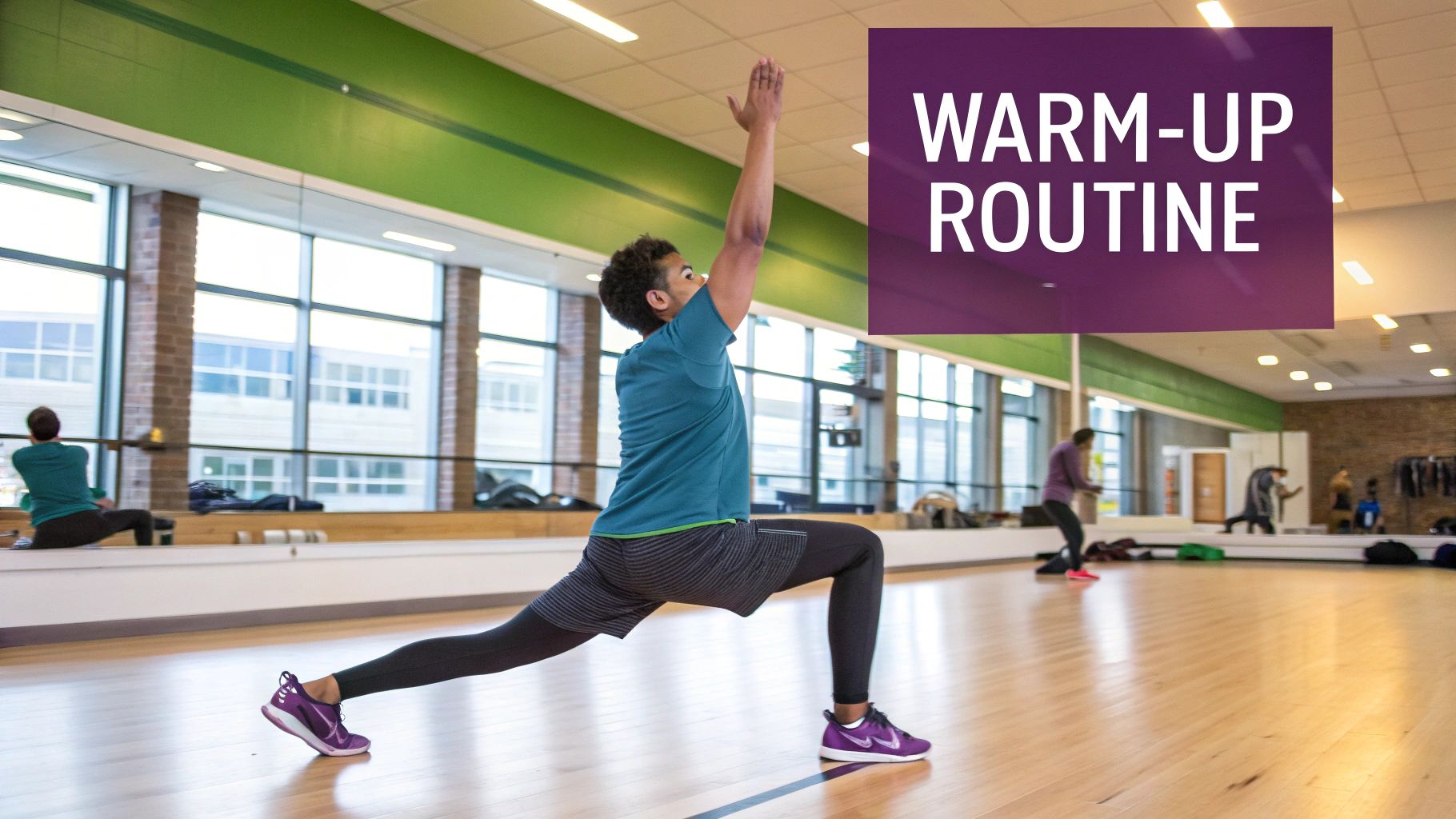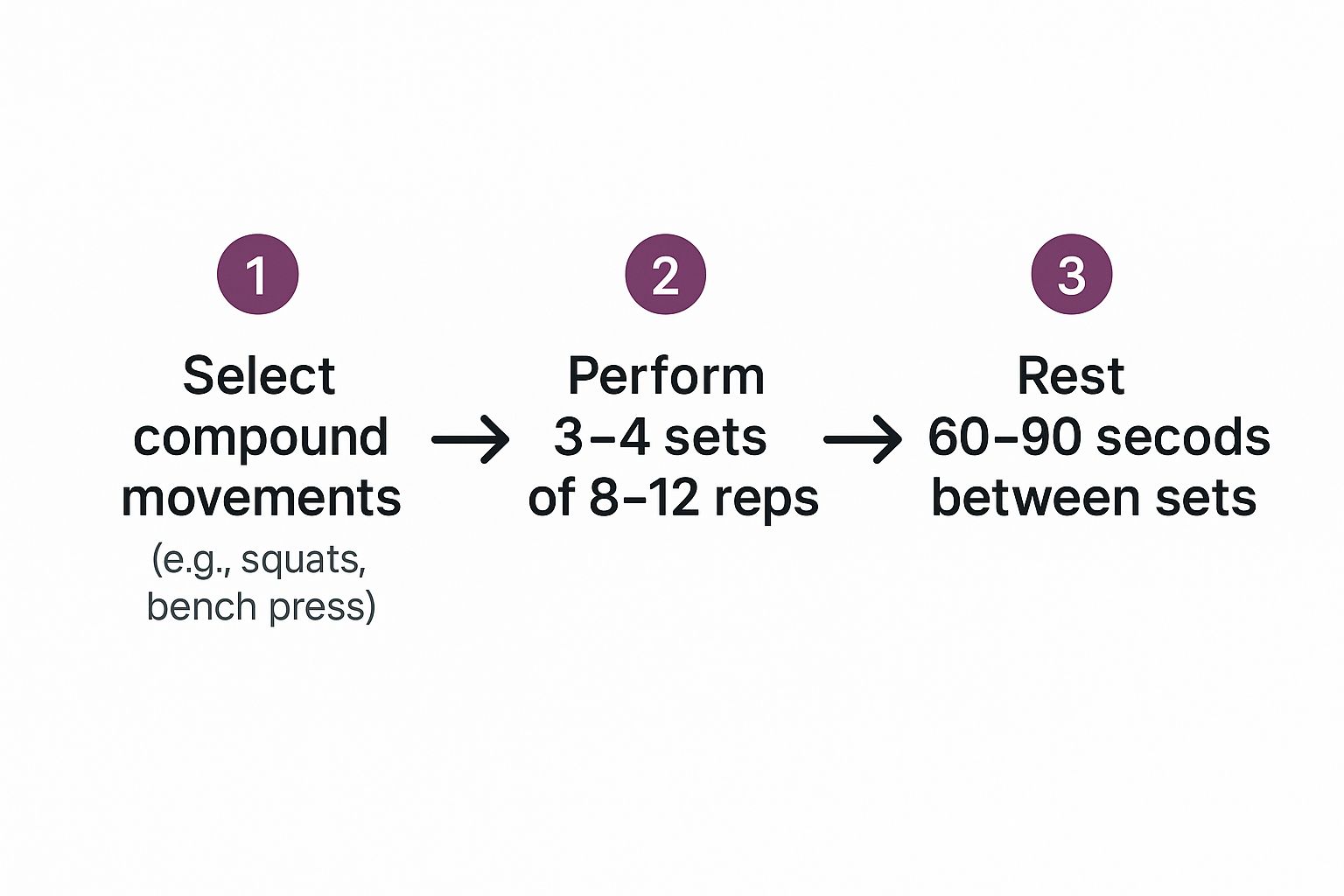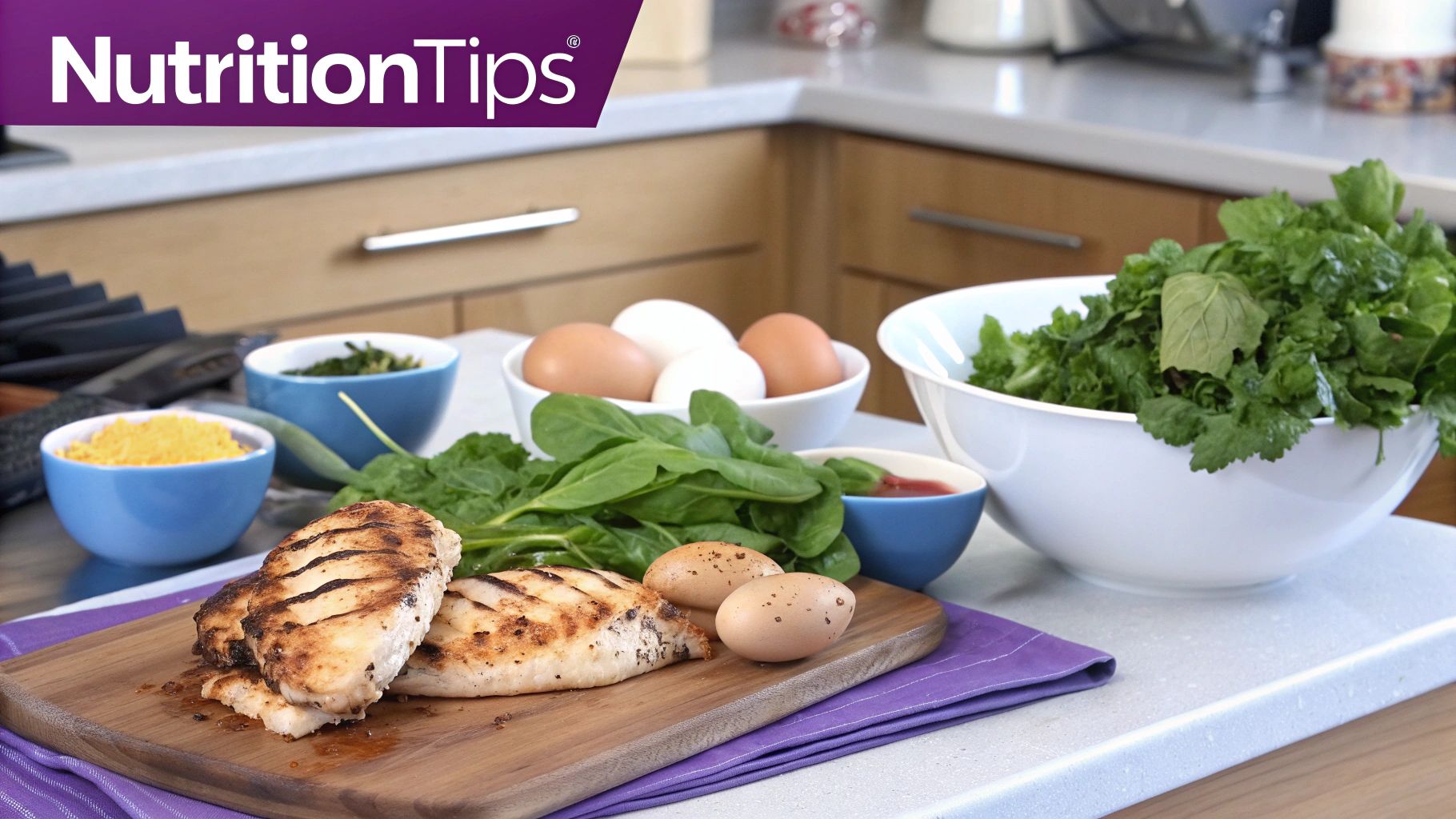
Effective Muscle Building Exercise Routines for All Levels
Before you ever pick up a dumbbell, it’s worth understanding why your muscles grow. Knowing the science behind it—a process called hypertrophy—can make every rep you perform more effective.
This isn’t about just mindlessly lifting heavy stuff. It's about creating a specific biological response that forces your body to adapt and build.
How Muscle Building Actually Works
The foundation of any solid muscle-building plan is one core principle: progressive overload.
Think of it this way: your body is an adaptation machine. It's also incredibly efficient and won't change unless you give it a compelling reason to.
If you lift the same 100 pounds for 10 reps week after week, your body quickly says, "I've got this," and stops growing. You have to consistently up the ante, whether that means adding more weight, pushing for more reps, or shortening your rest periods.
The Three Triggers for Muscle Growth
To kickstart hypertrophy, your training needs to hit three key mechanisms. You don't have to max out all three in every workout, but a well-designed routine will blend them.
-
Mechanical Tension: This is the big one. It's the force your muscles generate when you lift a challenging weight through its full range of motion. Heavy, compound exercises like squats, deadlifts, and bench press are king here.
-
Muscle Damage: When you push your muscles hard, you create microscopic tears in the muscle fibers. This controlled damage signals your body to start the repair process, leading to post-workout soreness and growth.
-
Metabolic Stress: You know that tight, swollen feeling you get during a high-rep set? That's the "pump," and it's a sign of metabolic stress. It happens when byproducts like lactate build up, causing the cells to swell and signal growth.
You Can’t Out-Train a Bad Diet
Lifting weights is what breaks your muscles down, but your nutrition is what builds them back up—stronger than before. Without the right fuel, even the most grueling workout plan will get you nowhere. The two are completely intertwined.
Your body needs enough calories for intense workouts and muscle repair. More importantly, it demands a steady supply of protein, the literal building block of new muscle tissue.
For anyone serious about building muscle, you should aim for 1.4 to 2.2 grams of protein per kilogram of body weight each day.
I see it all the time: people crush themselves in the gym but completely ignore what they eat. That's like trying to build a brick house without any bricks. It's a recipe for frustration.
A simple way to hit your numbers is to include a quality protein source with every single meal. Spreading your intake out every 3 to 4 hours gives your muscles a constant stream of amino acids.
If you want to dive deeper into structuring your meals in a more visual and engaging way, our Diet & Exercise Coloring Book can make learning nutrition genuinely fun.
Building an impressive physique means training smart and eating even smarter. When you combine progressive overload with the right nutritional strategy, you create the perfect environment for consistent muscle growth.
Your First Muscle Building Routine

Starting out can feel overwhelming, but the first steps matter most. This beginner-friendly plan is all about building a rock-solid foundation of strength and confidence.
We’re going to focus on a full-body routine that is simple but incredibly effective, built on compound exercises—movements that hit multiple muscle groups at once like squats and deadlifts.
These are the heavy hitters of any solid program because they fire up more muscle fibers and trigger a much bigger growth response than isolation exercises.
Your Foundational Full-Body Workout Plan
The plan is to train three times a week on non-consecutive days. A Monday, Wednesday, and Friday schedule is classic for a reason: it gives your muscles the crucial 48 hours they need to recover, repair, and grow.
Here’s a simple and effective muscle building exercise routine to get you started:
- Workout A: Squats, Bench Press, Barbell Rows
- Workout B: Deadlifts, Overhead Press, Pull-Ups (or Lat Pulldowns)
You'll simply alternate between these two workouts. For example, your first week might look like this: Monday (A), Wednesday (B), Friday (A). The next week, you'd start with Workout B.
For every exercise, aim for 3 sets of 8-12 repetitions. This is widely considered the sweet spot for hypertrophy. If you can't hit 8 reps, the weight is too heavy. If you can breeze past 12, it's time to add more weight.
Globally, a staggering 31% of adults are physically inactive. This shows how much of an impact accessible routines like this one can have on people's health.
Mastering the Core Lifts
Perfecting your form isn't just a suggestion; it's non-negotiable. Bad form doesn't just hold back your results—it's a fast track to getting injured.
It's always better to lift a lighter weight with perfect technique than to let your ego take over and lift a heavy weight with sloppy form.
Here’s a quick rundown on the cornerstone movements:
-
The Squat: This is the king of leg exercises. Keep your chest up and back straight, lowering yourself until your thighs are at least parallel to the floor.
-
The Bench Press: The ultimate chest builder. Keep your feet planted, maintain a slight arch in your lower back, and lower the bar to your mid-chest before pressing it back up.
-
The Deadlift: A true full-body movement. The key is lifting with your legs and hips, not your back. Keep your back flat from start to finish.
How to Choose Your Starting Weight
"How much weight should I lift?" is a common question. The answer depends on your current strength, so you'll need a little smart trial and error.
Start with just the empty barbell to feel the movement. Then, add a small amount of weight and perform a set. You're looking for a weight that makes the last couple of reps in your 8-12 range feel challenging, but not impossible.
Many people find that training at home is a great way to build initial confidence. If that sounds like you, check out our guide on workout routines for beginners at home for great ideas.
Combining Diet with Your New Routine
Lifting weights is only half the battle. To build new muscle, your body needs enough calories and plenty of protein.
You’ll need to be in a slight caloric surplus, which means eating 250-500 calories more than your body burns. This encourages muscle gain while minimizing fat gain.
Protein is the raw material for muscle repair. Aim for 1.6 to 2.2 grams of protein per kilogram of your body weight each day. Spread this out over several meals. Foods like chicken, lean beef, fish, eggs, and Greek yogurt should become staples.
Intermediate Routines for Serious Gains
So, you’ve been hitting the gym consistently, and those "newbie gains" are starting to slow down. Hitting a plateau means you're getting stronger. Your body has adapted, and now it’s begging for a bigger challenge.
For lifters ready to take that next step, one of the most battle-tested muscle building exercise routines is the Push/Pull/Legs (PPL) split. It’s an efficient system that groups muscles based on how they function.
So, How Does Push Pull Legs Work?
The logic behind PPL is straightforward. Instead of hitting everything at once, you dedicate entire sessions to specific movement patterns.
- Push Day: This is where you train all your upper-body "pushing" muscles: chest, shoulders, and triceps.
- Pull Day: Next, you focus on all the "pulling" muscles—your entire back and your biceps.
- Leg Day: This whole workout is dedicated to your lower body: quads, hamstrings, glutes, and calves.
This kind of split lets you hit each muscle group with more volume and intensity than you could in a full-body routine, which is exactly what you need to trigger new growth.
It all boils down to picking the right compound lifts, hitting them with enough sets and reps, and then getting proper rest.

That simple cycle—a solid main lift, performed in the right rep range, followed by adequate rest—is the foundation of any workout plan that gets results.
How to Schedule Your PPL Routine
When it comes to scheduling, you’ve got a couple of solid options depending on your recovery and how many days a week you can train.
The 4-Day PPL Split: This is a fantastic setup if your schedule is tight or if you need more time to recover. A common way to run this is: Push, Pull, Rest, Legs, Rest, then start over.
The 6-Day PPL Split: If you recover well, the 6-day split is a classic. It maximizes your training volume by running Push, Pull, Legs, Push, Pull, Legs, followed by a single rest day.
A Solid Intermediate PPL Workout Plan
Here’s a sample PPL routine to get you started. It’s built around heavy compound lifts followed by isolation work to add volume.
Push Day
- Barbell Bench Press: 3 sets of 6-8 reps
- Incline Dumbbell Press: 3 sets of 8-12 reps
- Seated Dumbbell Shoulder Press: 3 sets of 8-12 reps
- Lateral Raises: 4 sets of 12-15 reps
- Tricep Pushdowns: 3 sets of 10-15 reps
- Overhead Tricep Extensions: 3 sets of 10-15 reps
Pull Day
- Deadlifts: 3 sets of 5-6 reps (or Barbell Rows for 3 sets of 6-8 reps)
- Pull-Ups (or Lat Pulldowns): 3 sets to failure (or 8-12 reps)
- Seated Cable Rows: 3 sets of 8-12 reps
- Face Pulls: 4 sets of 15-20 reps
- Barbell Curls: 3 sets of 8-12 reps
- Hammer Curls: 3 sets of 10-15 reps
Leg Day
- Barbell Squats: 3 sets of 6-8 reps
- Romanian Deadlifts: 3 sets of 8-12 reps
- Leg Press: 3 sets of 10-15 reps
- Leg Extensions: 3 sets of 12-15 reps
- Lying Leg Curls: 3 sets of 12-15 reps
- Calf Raises: 4 sets of 15-20 reps
The secret sauce for any intermediate lifter is progressive overload. You must find ways to make your workouts harder over time. That could mean adding 5 lbs to your bench press or fighting for one extra rep.
This focus on compound movements is the core of functional fitness, a top fitness trend for 2025 because it builds real-world strength. Explore new fitness trends when you have the time, to see why it’s so popular.
Don't Forget to Fuel Your Work
As you ramp up the intensity, your body's need for fuel skyrockets. A PPL routine creates a lot of muscle damage, and you need to provide the raw materials to repair that tissue.
This is where your protein intake becomes non-negotiable. Having a high-quality protein source right after your workout is a game-changer for recovery. A fast-digesting whey protein shake is an easy and effective option.
If you need a reliable way to mix your post-workout fuel, our Diet & Exercise Protein Shaker Bottle is the perfect tool to get those crucial nutrients in right when you need them most.
Advanced Techniques to Break Through Plateaus

Sooner or later, every serious lifter hits "the wall." It's that frustrating point where progress just grinds to a halt.
Don't panic. This isn't a sign of failure; it's your body's way of telling you it has adapted. It needs a serious wake-up call to start growing again. The trick is to intelligently shock your system with new, powerful stimuli.
Intensity Techniques to Reignite Growth
When your standard 3x10 just isn't cutting it anymore, it's time to bring out the big guns. The goal is to push your muscles past their normal point of failure, which triggers a powerful adaptive response.
Here are a few go-to methods to weave into your muscle building exercise routines:
- Drop Sets: This one is brutal but effective. Take an exercise to failure, then immediately strip off 20-30% of the weight and keep repping until you fail again.
- Supersets: The classic time-saver. Pair two exercises back-to-back with zero rest. Try it with opposing muscle groups (like bicep curls into tricep pushdowns).
- Rest-Pause Training: Take a weight you can lift for 6-8 reps. Push to failure, rest for 15-20 seconds, and then grind out a few more reps. This gets you more total reps with a heavier weight.
A word of caution: these techniques are incredibly demanding. Don't apply them to every exercise in your workout. Use one on the final set of an isolation exercise to completely finish off the muscle.
The Power of Smart Programming: Periodization
Going all-out, all the time is a one-way ticket to injury or burnout. This is where periodization comes in. It’s the art of organizing your training into distinct cycles to manage fatigue.
A simple model is linear periodization, where you cycle through different phases.
| Training Phase | Main Goal | Rep Range | Intensity |
|---|---|---|---|
| Hypertrophy | Muscle Size | 8-12 reps | Moderate-High |
| Strength | Max Strength | 4-6 reps | High |
| Endurance | Work Capacity | 15-20 reps | Low-Moderate |
| Deload | Active Recovery | 10-12 reps | Very Low |
Switching between these phases every few weeks keeps your body guessing and prevents it from fully adapting. With intense methods like these, recovery is everything. If you struggle to bounce back, check out our guide on how to recover faster.
Remember, these advanced strategies are tools, not the entire toolbox. Their purpose is to provide a targeted shock to break through a sticking point, not to replace the core principles of progressive overload.
Fueling for Peak Performance
When you're asking your body to perform at this level, your nutrition and supplementation become non-negotiable. You can't expect to push through a grueling drop set if you're running on fumes.
A quality pre-workout supplement can give you a tangible edge. Look for one with proven ingredients that boost energy, sharpen focus, and improve blood flow.
The right pre-workout can be the difference-maker that helps you squeeze out those final, growth-stimulating reps. For a formula designed to support these intense efforts, consider our Diet & Exercise Pre-Workout.
Fueling Your Body for Optimal Muscle Growth

All the sweat you pour into your muscle building exercise routines is just one side of the coin. The other, equally crucial part happens in your kitchen.
Without the right fuel, your body can't repair the muscle you break down and rebuild it bigger and stronger. Think of your diet as the foundation—if it’s shaky, everything you build on top of it will be, too.
This isn't about complicated meal plans. It's about nailing the fundamentals: protein, carbohydrates, fats, and enough total calories to support growth.
Calculating Your Fuel Needs
To build muscle, you have to be in a slight caloric surplus. You need to consume more energy than your body burns each day.
A great starting point is a surplus of 250-500 calories above what you need to maintain your current weight. This gives your body extra energy for muscle repair without packing on a lot of unwanted body fat.
Of all the macros, protein is king. For anyone lifting weights seriously, a solid target is 1.6 to 2.2 grams of protein per kilogram of body weight.
Your body is constantly breaking down and rebuilding protein. By feeding it high-quality protein every 3-4 hours, you shift the balance toward rebuilding, which is exactly the state you need to be in for muscle growth.
Building Your Muscle-Building Plate
Forget the fancy recipes for now. Your meals should be built around simple, nutrient-dense whole foods. Each time you eat is an opportunity to fuel your body.
A typical day of eating might look something like this:
- Breakfast: Scrambled eggs with spinach and a side of oatmeal.
- Lunch: Grilled chicken breast with quinoa and a big salad.
- Post-Workout: A whey protein shake and a banana. We cover more tips like this in a short video on the dietexercise YouTube channel.
- Dinner: Salmon with roasted sweet potatoes and broccoli.
Here's a sample plan to give you a clearer picture of how these macros and calories can be distributed.
Sample Muscle-Building Macronutrient Plan
This table provides a sample daily plan for a 180 lb individual aiming to build muscle. Adjust these numbers based on your specific activity level, metabolism, and progress.
| Meal | Protein (g) | Carbs (g) | Fats (g) | Example Foods |
|---|---|---|---|---|
| Breakfast | 40 | 50 | 20 | 4 eggs, 1 cup oatmeal, 1/2 avocado |
| Lunch | 45 | 60 | 15 | 6 oz chicken breast, 1 cup rice, mixed greens |
| Pre-Workout | 25 | 40 | 10 | Greek yogurt, banana, small handful of almonds |
| Post-Workout | 40 | 50 | 5 | Whey protein shake, 2 rice cakes with honey |
| Dinner | 45 | 50 | 25 | 6 oz salmon, 8 oz sweet potato, 1 cup broccoli |
| Totals | 195g | 250g | 75g | ~2,455 Calories |
This plan is just a template. The key is to find what works for you and stay consistent.
Nutrient Timing for Better Performance
While hitting your daily targets is the top priority, when you eat can give you a slight edge. The meals surrounding your workout are especially important.
Eating a meal with protein and carbs 1-2 hours before you train ensures your muscles are loaded with fuel. Likewise, getting a protein-rich meal or shake in within an hour or two after your workout kickstarts the muscle repair process.
If you're looking for a fun way to internalize these concepts, our Diet & Exercise Coloring Book offers a creative way to visualize and remember the fundamentals of building a healthy plate.
Your Top Muscle-Building Questions Answered
When you're trying to build muscle, you're bound to run into questions. Getting clear, honest answers is the best way to cut through the confusion.
Let's dive into some of the most common questions I hear and set the record straight so you can keep making progress.
How Long Until I Actually See Results?
This is the big one. You'll likely feel stronger within a couple of weeks. That initial boost isn't new muscle—it's your nervous system getting more efficient.
Visible muscle growth takes more patience. For most people, noticeable changes in size and definition start to show up after about 8-12 weeks of consistent effort. Consistency is everything.
Do I Really Need to Take Supplements?
No, supplements aren't a requirement. Your foundation is, and always will be, a solid muscle building exercise routine and a diet that provides enough protein and calories.
Think of it this way: food is the building material, and supplements are the specialized tools. A good whey protein powder can make hitting your daily protein goals easier. Creatine is proven to help with strength. Just remember they are there to help, not to do the work for you.
Supplements are just that—supplemental. They are meant to fill the gaps in an already solid foundation of training and whole-food nutrition, not replace it.
How Big of a Deal Are Rest and Sleep?
They're a massive deal. Rest and sleep are just as critical as your time in the gym. Your muscles don't grow while you're lifting; they grow when you're resting.
As a rule of thumb, give a muscle group at least 48 hours to recover before hitting it hard again. This is why a well-structured training split is so effective.
Don't forget about sleep—it's your body's prime time for repair. Aiming for 7-9 hours of quality sleep each night is essential for hormone regulation and muscle recovery. If you neglect sleep, you're undercutting your progress.
At Diet and Exercise, we know that pairing a smart workout plan with the right knowledge is the key to unlocking your true potential. We're here to help you build a stronger, healthier you with our guides and supportive products.
Find the gear and apparel you need to support your fitness journey at our official store. You can see the full collection at https://dietexerciseshop.com.
